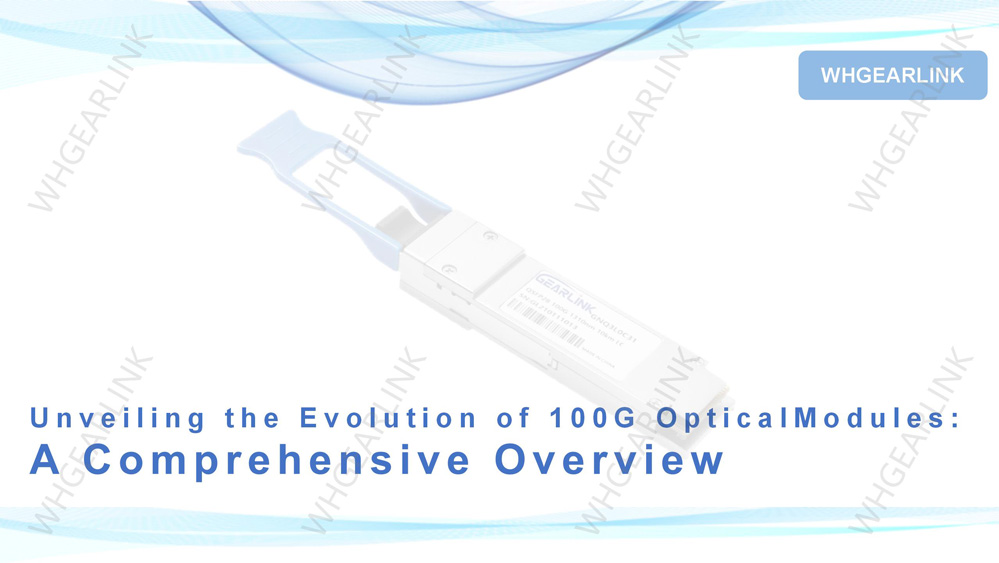
Abstract: In the fast-paced world of data transmission, the demand for higher bandwidth and faster speeds continues to escalate. As data-intensive applications such as cloud computing, artificial intelligence, and high-definition video streaming become increasingly prevalent, the need for robust and efficient optical modules capable of delivering 100Gbps speeds has never been more critical. In this article, we delve into the introduction of 100G single-mode and multi-mode optical modules, exploring their classifications, packaging methods, and key features.
100G optical modules come in various packaging formats, each tailored to specific requirements and applications. The most common packaging methods include:
CFP (C Form-factor Pluggable): Originally developed to support 100Gbps Ethernet, CFP modules are large in size and support a wide range of optical interfaces. However, due to their size, they are gradually being replaced by smaller form factors.
CFP2 (C Form-factor Pluggable 2): CFP2 modules offer a more compact form factor compared to CFP, providing higher port density while maintaining support for 100Gbps speeds.
CFP4 (C Form-factor Pluggable 4): CFP4 modules further reduce size and power consumption compared to CFP2, making them ideal for high-density applications such as data centers.
QSFP28 (Quad Small Form-factor Pluggable 28): QSFP28 modules are widely used for 100Gbps Ethernet and InfiniBand applications, offering a compact form factor with support for four independent channels of up to 25Gbps each.
Within the QSFP28 category, 100G optical modules are classified based on their intended use and specifications. The main classifications include:
QSFP28 100G SR4: Short-Range QSFP28 modules QSFP28 100G SR4 are designed for transmission distances of up to 100 meters over multi-mode fiber, utilizing four parallel fibers for data transmission.
QSFP28 100G PSM4 (Parallel Single Mode Fiber): PSM4 modules leverage four independent lanes operating on single-mode fiber for longer transmission distances, typically up to 500 meters.
QSFP28 100G CWDM4 (Coarse Wavelength Division Multiplexing): CWDM4 modules utilize four different wavelengths to transmit data over a single fiber, enabling longer transmission distances of up to 2 kilometers.
QSFP28 100G LR4 (Long-Range): 100g LR4 modules are optimized for longer transmission distances of up to 10 kilometers over single-mode fiber, utilizing four wavelengths for data transmission.
QSFP28 100G ER4 (Extended-Range): ER4 modules offer even greater reach, supporting transmission distances of up to 40 kilometers over single-mode fiber, making them suitable for metro and regional networks.
QSFP28 100G ZR4 (Zettabyte Range): ZR4 modules provide extended reach for ultra-long-haul transmission, supporting distances of up to 80 kilometers over single-mode fiber.
Classifications of 100G Multi-mode Optical Modules
Multi-mode optical modules are designed for short-range data transmission within data centers and other high-performance computing environments. The main classifications of 100G multi-mode optical modules include:
QSFP28 100G SR4: Short-Range QSFP28 modules utilize four parallel fibers for data transmission over distances of up to 100 meters, making them ideal for high-density interconnects within data centers.
QSFP 100G SRBD (Short-Range Bidirectional): SRBD modules leverage bidirectional transmission over two fibers, offering cost-effective short-range connectivity for data center applications.
QSFP 100G SWDM4 (Short-Wavelength Division Multiplexing): SWDM4 modules use Short-Wavelength Division Multiplexing technology to transmit four channels of data over a single multi-mode fiber, extending transmission distances up to 100 meters.
As the demand for high-speed data transmission continues to surge, the introduction of 100G optical modules marks a significant milestone in the evolution of networking technology. Whether it's single-mode or multi-mode, these optical modules offer versatile solutions for a wide range of applications, from short-range data center interconnects to long-haul network deployments. By understanding the classifications, packaging methods, and key features of 100G optical modules, organizations can make informed decisions to meet their specific networking requirements and propel their digital initiatives forward.
Which is the most popular 100G optical module on the market?
The QSFP28 (Quad Small Form-factor Pluggable 28) optical module is currently the most popular 100G optical module on the market. It offers a compact form factor, high-speed data transmission capabilities, and broad compatibility, making it widely adopted in data centers, enterprise networks, and telecommunications infrastructures.
Where are 100G optical modules most used?
100G optical modules are most commonly used in data centers, telecommunications networks, and enterprise environments where high-speed data transmission is essential. They facilitate efficient communication between servers, switches, routers, and storage systems, supporting bandwidth-intensive applications such as cloud computing, big data analytics, and high-definition video streaming.

